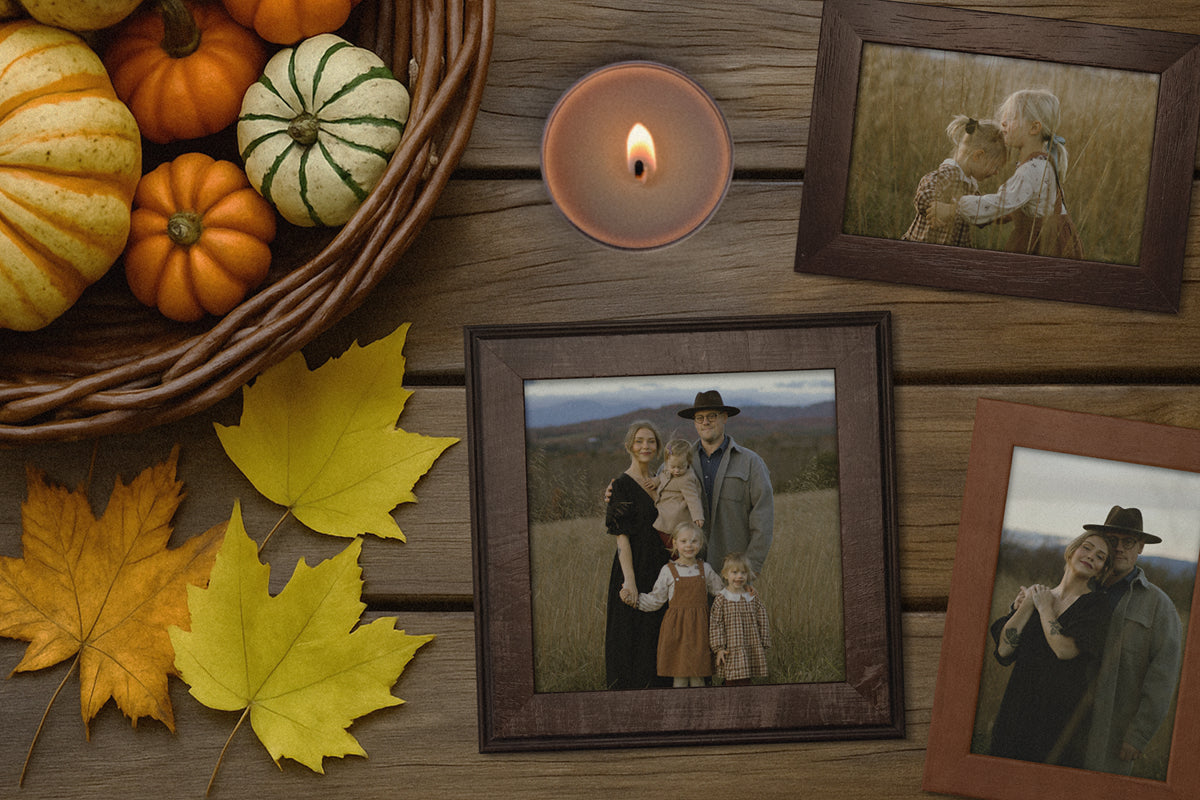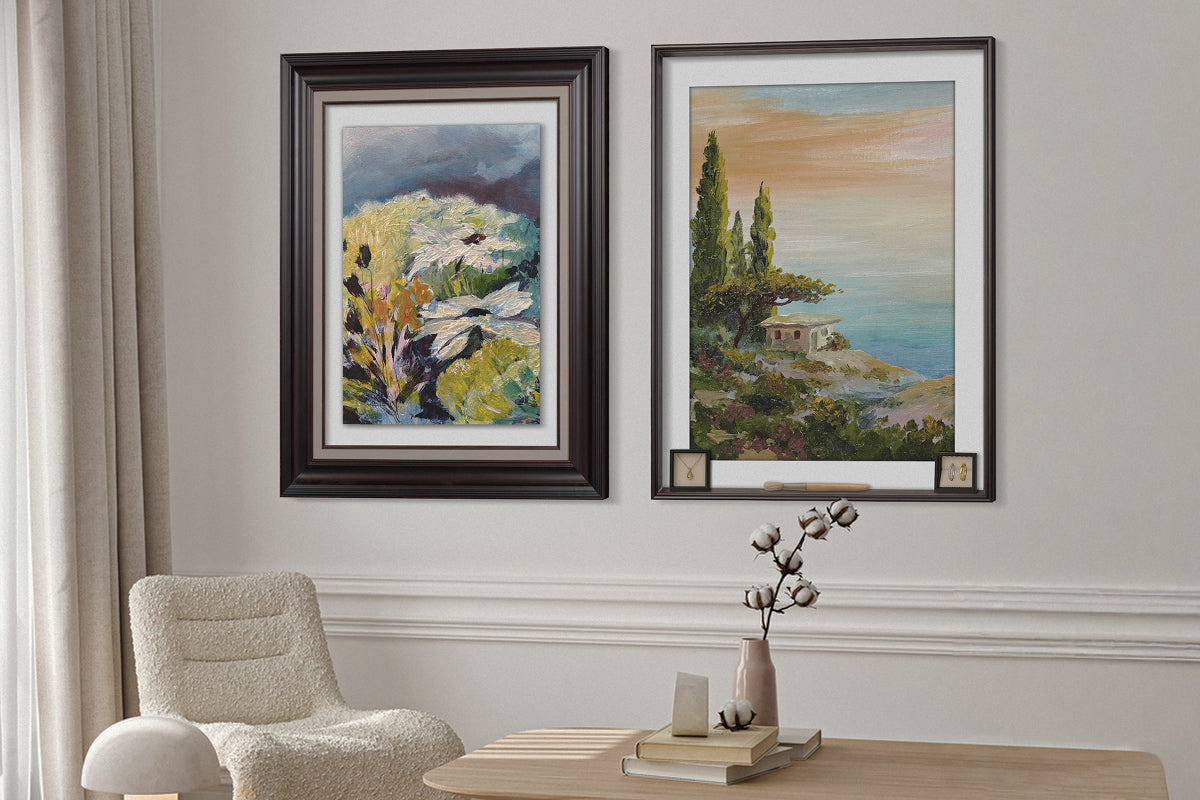When framing any piece of art, seek balance between style and practicality. In photo framing, you need durable frames that fit your photography's theme and physical dimensions.
In this guide, we'll simplify the framing process with expert advice from photo framing professionals and photographers. We'll teach you about various photo frame materials, sizes, and styles to help you make an informed choice.
The Core Elements Of Photo Framing
Here are some important factors to consider when framing your photos:
- Frame Material: Wooden frames are a great choice for their elegance and strength. You can also choose metallic or plastic frames, which come in different styles and have their own distinct features.
- Frame Size: Find the appropriate frame size to match your photo's dimensions. Custom sizes are available for special pieces.
- Frame Style: Select a frame color and style that enhances not just your photo, but also your décor.
- Protective Features: TFC’s wooden frames include a safeguarding finish to protect against scuffing. Optional framing accessories can prevent issues like fading and glaze adhesion.
Choosing The Right Material
Wood, metal, and plastic are three of the most common types of picture frames. Let's take a look at the benefits and drawbacks of each material.
Wood Frames
One advantage wooden frames have over other materials is their versatility. Wooden picture frames come in a wide variety of styles, from classic to modern, making it easy to find a frame that complements any photo and décor. Their natural look and feel add a touch of elegance and warmth to any setting.

Pros:
- Aesthetic Appeal: Wooden frames fit both vintage and contemporary settings, with various finishes and colors.
- Durability: TFC wooden picture frames are especially durable. They feature premium moulding and finish, and they last for years.
- Customizability: Wooden frames are often customized to fit non-standard photo sizes or unique artistic pieces. They're a versatile choice for personalized framing.
Cons:
- Weight: Bigger wooden frames can be pretty heavy. Keep this in mind when framing large pictures.
- Cost: Quality picture frames made from high-end wood are generally more expensive than frames made from other materials, but this often prices in better durability and craftsmanship.
- Vulnerability: Unfinished wood frames are more susceptible to damage from moisture, pests, and general wear and tear than finished frames. Proper finishing is essential to protect them from these elements.
Metal Frames
Metal frames often have a modern appeal and feature practical benefits. They’re a good option for those seeking durability in busy settings.
Pros:
- Sleek Look: With their minimalist appearance, metal frames are perfect for industrial and urban décor.
- Durability: Frames made from metal are typically durable and tough, suitable for high-traffic spaces.
- Weight: Metallic frames are usually lightweight, which helps with hanging and handling, as well as damage prevention.
Cons:
- Limited Styles: Metal frames are often more limited in terms of design and finish compared to frames made of wood.
- Potential for Dents: Metal picture frames can dent when subjected to heavy impact.
- Corrosion Risk: If not properly treated, some metal frames can be prone to rust or corrosion, especially in humid environments.
Plastic Frames
Plastic picture frames include standard styles and acrylic frames that encase the picture within clear acrylic material alone.
Pros:
- Modern Style: Plastic photo frames suit modern interior design pretty well.
- Weight: Plastic frames are lightweight, making them easy to handle and display.
- Cost: Budget-friendly plastic photo frames are widely available at many major art or household supply stores.
Cons:
- Scratching: Although some plastic photo frames are scratch-resistant, the majority are prone to scratch easily.
- Static Electricity: Static electricity in plastic picture frames can attract dust, requiring more frequent cleaning than other framing materials.
- Discoloration: Plastic frames can become discolored with long-term exposure to direct sunlight.
Understanding Frame Sizes And Their Impact
Certain frame sizes are best suited for particular kinds of pictures, such as 4x6 for casual shots and 8x10 for professional portraits.
Standard Frame Sizes
Standard frame sizes help to fit standard photo dimensions. This makes them a practical choice for most photos. These are some common frame sizes and their recommended uses:
-
4x6 inches: Perfect for small snapshots, like travel pictures or pet photos.

-
5x7 inches: Great for photographic portraits or small artworks.

-
8x10 inches: Frequently chosen for family photos and medium-sized prints.

-
11x14 inches: Ideal for art prints, posters, and larger photos.

-
16x20 inches: Great for showing off big pictures or art pieces.

-
20x24 inches: Typically displays significant artworks and large images.

Custom Frame Sizes
When you've got photos with unique or non-standard sizes, custom frames are your best bet. They ensure a perfect fit, so your photo can stay intact without any cutting or alteration.
This is especially useful for panoramic images, artistic works, or any photograph that doesn’t conform to typical sizes. At TFC, our custom framing solutions provide a tailored fit for your special photos.
Visual Balance And Focus

The size of a picture frame is identified by its picture area (not the outer edges of the frame). While matching a photo to a frame by exact dimensions is common, smaller photos can also fit larger frames if the aspect ratios align, usually with the help of matting. Aspect ratio refers to the proportional relationship between the width and height of an image or frame.

Evaluate the proportion of the room and the wall where the photo will be displayed. A large frame on a small wall can overwhelm the space, while a small frame on a large wall might look insignificant. The frame should complement the artwork and accent the décor, enhancing the aesthetic without dominating it.
Color Coordination And Style Matching
The right frame color and style will boost the appearance of both your photo and the room. A well-chosen frame can significantly improve a photo’s visual impact and ensure it matches the surrounding décor. Remember, the frame should accent the subject in the art, bringing focus to the parts of the piece you want to highlight.
Consider The Photo’s Color Palette
Your picture frame should complement the color scheme of your photo, rather than clash with or overpower it.
-
Black And White Photos: Black-and-white photographs tend to have a classic or timeless aura to them. Black, white, or metallic frames complement black-and-white photos. Depending on your décor, black frames can appear bold, white frames more understated, and metallic frames can introduce a modern, luxurious, or industrial look to the display.

-
Sepia Photos: Sepia-toned photos typically pair well with warm-colored frames. Gold, bronze, or natural wood tones enhance the vintage charm of these pictures.

-
Color Photos: For vibrant-colored photos, select frames that match a dominant color or neutral frames to highlight your images. Cool-toned photos (blue and green hues) look good with gray frames, while warm-toned photos (red, orange, and yellow shades) pair nicely with gold frames.

Match The Room’s Décor
The frame should harmonize with the room's style and color scheme. Think about the existing furnishings, wall colors, and other decorative elements to ensure aesthetic cohesion.
-
Modern Interiors: Minimalist frames in black, white, or metallic colors are great for modern interiors, providing a clean appearance that matches the décor.

-
Traditional Interiors: If you want to add elegance and sophistication, opt for decorative wood frames or frames with gold accents. Frames with detailed engravings often work well in classic interiors.

-
Eclectic Interiors: Create an eclectic gallery by experimenting with different frames and styles. Mix and match picture frames to bring a personal touch and character to your décor.

Protective Features For Longevity
The right protective features for your photo frames help them stay in great condition. Various options are available to suit different styles and environments.
Frame Finishes
The finish of a photo frame can greatly impact its longevity. For example, the finish on TFC's wooden picture frames provides a safeguard against scuffing and environmental damage.
UV-Protective Glazing
Ultraviolet rays from sunlight and indoor lighting can cause significant damage to photographs, leading to fading and discoloration. One of the most effective ways to protect your photos is by using a UV-protective glaze.
Frame Liners
Frame liners safeguard photos by forming a buffer between them and the glaze, preventing harm from condensation and sliding. They’re similar to mats but are usually covered in fabric and not always decorative. Liners and mats can be combined for increased protection and improved visual appeal.
Backing Materials
Backing materials provide support and prevent environmental damage. Acid-free foam board is a lightweight and sturdy option, offering excellent support without harmful chemicals. Archival backing paper provides a barrier against dust and moisture.
Making Your Decision
The best frames for photos depend on your needs and preferences. Choose frames that offer elegance, protection, and a personal connection to display and preserve your cherished memories. Visit TheFrameCompany.com to explore a variety of high-quality frames to perfectly complement your photos and décor.







